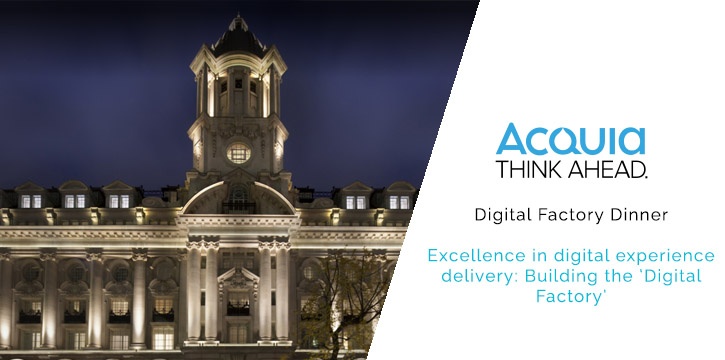The digital factory dinner took place at Rosewood, London, on the 16th November. It was a chance for executives from brands including consumer goods, high street banks, and software companies, to talk over dinner and drinks about the challenges they faced and some of the solutions they might implement.
The key talking themes of the topic were:
- How to keep pace with customer expectations in the digital age
- The key to consistency: challenges across multi-site brands
- Ensuring scalability: standardising complex multichannel digital operations
- Understanding security challenges and derisking digital assets
- The critical components of digital success: assembly, delivery operations and governance
The dinner was conducted in partnership with Acquia. Acquia is a content management service designed to create flexible solutions across content delivery at scale.
Better. Faster. Cheaper
The infrastructure of London heaves with the weight of traffic. Cars are rerouted where they should go directly, people are stuck in jams, streets are too complex to navigate, and the tube is packed with commuters. This is not purely negative: London’s character is to some extent intertwined with this inefficiency. But the same cannot be said for bluechips’ digital experiences, which suffer from similar problems of scale.
On this kind of scale, digital transformation happens across scores of countries; hundreds of offices; and several channels. Too often, the result is a bitty and raggedy set of customer interactions, and a failure to successfully thread an experience together. The brand ends up totally inconsistent across different channels. Where every regional office is making digital decisions, there isn’t scope to benefit from digital Fordism.
It would clearly be unacceptable to burn London to the ground and start again, however much more efficient a city planned from the start would be. And though it is far more tempting to push a sclerotic digital system to the point where it could break, to show a new one is needed, failure is unacceptable in most industries today. The expectation is set, and the unglamorous job of people at the top of digital is simultaneously to argue a system isn’t fit for purpose, and run it so that it never fails.
The challenge becomes, how do you build a technology architecture that operates from the centre? How do you apply the Henry Ford model whilst at the same time allowing the flexibility?
The Same Hymn Sheet
One of the biggest challenges for CTOs is to take their argument for digital transformation to the people controlling the budget. A psychological shift needs to take place. At some point management needs to stop thinking in terms of digital transformation – and simply think about transformation. Digital is not frills and is not an add-on: somewhere along the way, it becomes the base expression of what a business is. The budget should reflect that.
But not everybody lives in so perfect a world. It can be useful to think about the quest for budget for a digital as a kind of political campaign. Pursuing ‘hearts and minds’ is one tactic; lobbying key members of the organisation, another. It can also help to strategically consider how the CEO might be thinking and frame your issues in those terms. They are unlikely to be proactive from the perspective of investing in tech, but reactive from a customer standpoint.
Big numbers are scary, too, even for powerful people. Every year, U.S. congress will pass lots of smaller road budgets rather than one big one – even when the big contract would be cheaper – out of a perennial fear of big spending numbers appearing in the media. The question becomes, to reduce squeamishness, how can pain be reduced? Where possible, what about starting small projects which can be combined at a later date? Then, stitching these projects together is a smart way to integrate and save cost rather than a big spending project.
“Long term planning” might be redundant anyway – companies often think in quarters, and with the pace of change, businesses affected by digital evolve very rapidly. It can be useful to set clearly defined and common goals: if you are in a strong enough position, to set key metrics that everybody works to across the company, so that everybody is on the same page.
What a Business Is
Businesses have changed. Firstly, they have become radically more customer centric. This is because we understand customers a bit better (‘there is no such thing as useless data’ runs one adage). Although collection can be creepy, it doesn’t have to be. The customer is trying to tell you things all the time. All the business must do is listen.
Secondly, the new expectation by the customer is radically better and seamless service, (put by the CEO of one disruptor, “everything just kind of works”) alongside utter convenience. If they want to access different parts of a business, they will not want to have to repeat themselves. If they want to access a service, they will wish to do so immediately. If they are interacting with a brand, they will expect to do so in a way to suit them.
Everything from the customer side must be simple. But simplicity requires complexity; simplicity for the customers require contortions and machinations on the side of vendors.
The above changes all stem from digital transformation. Digital is not a department, it is now the main expression of most products/services.
Members working in digital departments of big businesses must consistently make the argument that many of these changes would take place anyway. The fight for a working consistent digital infrastructure which takes into account the customer and can be accessed in any locale is crucial for a company’s survival.





Leave a Comment